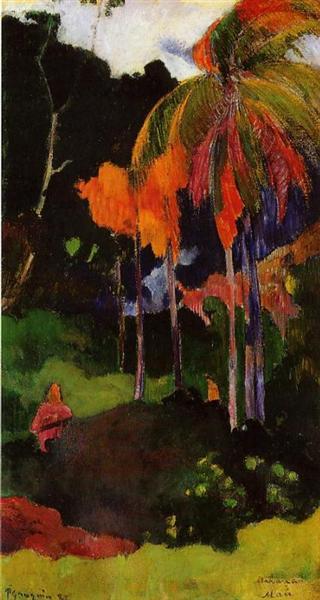Description
The work "The moment of truth and" by Paul Gauguin, carried out in 1892, is part of a fundamental period of the artist's life, marked by his intense search for a visual language that transcended the mere representation. This painting is not only a testimony of the post -impressionist style that Gauguin developed, but also an exploration of deep and existential issues that convene both the elementity of life and the complexity of human experience.
When observing the composition of "The Moment of Truth I", you can notice the deliberate distribution of the elements within the canvas. In the center of the work, two human figures, a man and a woman, are found in an enigmatic dialogue that evokes both emotional and psychological tensions. The man is represented in a tension posture, which suggests an imminent confrontation or decision that approaches. The woman, on the other hand, seems to be directly involved in this interaction, carrying with her the ambiguity of her intentions and emotions. Its expression is contemplative, reflecting an introspection that suggests the complexity of interpersonal relationships.
The use of color in this work is particularly remarkable. Gauguin displays a vibrant palette, rich in shades that vary from golden yellow to deep and green, creating an environment that oscillates between the real and the symbolic. This colorist approach is not only distinctive to the artist, but also fulfills a narrative function, accentuating the emotional climax that transcends the visible. The colors seem to vibrate, as if their meanings were multiple and complex, which invites the viewer to a deeper and personal interpretation.
In addition to the characters, the environment plays a crucial role in communicating the message of the work. The exuberant vegetation and the elements that seem to arise from the bottom of the canvas suggest a space that amalgams the natural with the spiritual. This choice of scenarios reveals a connection with Polynesian culture, which Gauguin studied and absorbed during his stay in Tahití. The atmosphere that is generated is closed and enveloping, adding a sense of intimacy to the interaction between the figures.
Symbolism is another fundamental layer in "the moment of truth I". Gauguin has cultivated a style that moves away from realism and, as he advances in his career, adopts representations that invoke deeper mysteries. The positions of the figures, as well as their eyes, create a space of interpretation that goes beyond a simple visual event, becoming an allegory of the internal struggle between morality, desire and destiny. The work, therefore, becomes a meditation on the human condition, about the decisive moment in which each individual faces the truth of their existence.
Gauguin, a pioneer of symbolism, seeks in his works to generate a direct emotional experience, and "the moment of truth and" meets this mission. It is less a story tells in images and more a space for reflection where aesthetics and content are intertwined, allowing each spectator to make their own introspective trip. Within the context of the art of the nineteenth century, Gauguin's painting opens roads towards new ways of seeing and understanding, which resonate in modern and contemporary aesthetics. This painting Encapsula not only a moment in the artist's life, but a brilliant flash on the eternal search for the human being for understanding himself and his place in the world.
KUADROS ©, a famous paint on your wall.
Hand-made oil painting reproductions, with the quality of professional artists and the distinctive seal of KUADROS ©.
Reproduction service paintings With a guarantee of satisfaction. If you are not completely satisfied with the replica of your painting, we refund your money 100%.

